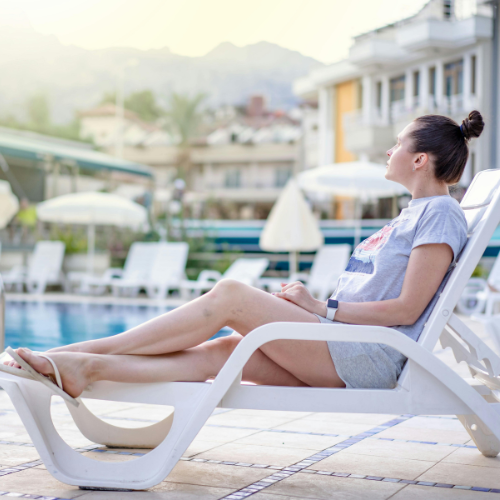It's Summer Holiday Time!
- Marlborough Chiropractic Clinic

- Jul 24
- 3 min read

For many of our patients, it’s the summer holiday season. Whether you’re travelling abroad or enjoying a staycation, we wanted to share some of the most common travel-related injuries we see – and how you can avoid them.
Read on for practical advice on seating set-up, how to use sun loungers safely, and our top tips for suitcase handling.
Getting your seat right!
Be it a car, plane or train seat, it’s so important to ensure you’re sitting correctly.
Often when sat in lower chairs, the lumbar spine is positioned in a slumped/posterior tilt position. This over-stretches the lower lumbar and pelvic joints and reduces their stability support. To reduce strain on the ligaments make sure you:
Place both feet flat on the floor, hip-width apart: Knees bent at roughly 90°, directly above your ankles. If this means your back doesn't reach the back of the seat, then place a pillow behind your back.
Adjust your pelvis: Gently rock your pelvis forwards and backwards a few times to feel the extremes (slump vs. over-arch). Settle in the middle – your pelvis slightly tipped forward, so you’re sitting on your “sit bones”, not your tailbone.
Move Regularly: Make an effort to move and stretch every 30 minutes. Simple stretches, such as reaching your arms overhead, rolling your shoulders, and gently twisting your torso, can help relieve tension.
Our Nemesis: The Sun Lounger!
Every year, we see several patients with back pain or injury caused by using sun loungers incorrectly. Here are some tips on avoiding common pitfalls and to protect your neck and back.
1. Posture and Alignment
Sunbeds are often made of hard plastic and are flat, which doesn't provide much support for the natural curves of your spine. Lying on such a surface for an extended period can exacerbate back pain or lead to discomfort, especially in the lower back.
If you're lying on your back: Use a towel or cushion and place it under your lower back and knees.
If you're on your front: Be it reading or chatting, place a rolled up towel under your pelvis.
If the sun lounger is in a reclined position: We recommend having the towel rolled behind your back to support the natural curve, and make sure you're sat on your sit bones.
2. Keep Moving!
Staying in a fixed position for a duration of the time on the lounger can cause stiffness and a sustained strain on the back muscles and ligaments, particularly if you have pre-existing back issues. Little movements – like pelvic tilts when you are laid down or getting up periodically to walk around the pool etc - can help limit the time-related strains.
3. Getting Off a Sun Lounger
It might seem straightforward, but when you're on a sunbed, your knees are usually higher than your hips, which can place your lower back in a risky flexed position as you attempt to stand. To safeguard your back, sit at the very edge of the sunbed, tilt your pelvis back and forth as described above to achieve a neutral pelvis. Use your legs to push yourself upright instead of lurching forwards. Alternatively, get onto all fours and crawl off the sunbed, making sure to engage your core as you lift your torso upright.

Packing for Your Holiday
Suitcases are another common culprit when it comes to holiday-related injuries. From poor lifting technique to overpacking, here’s how to protect your back.
Here are some top tips to avoid some of pitfalls when prepping and carrying your luggage:
Packing smart: Always pack your suitcase on a raised surface like a table or bench to avoid bending over. If you need to carry it downstairs, consider packing it at the bottom to avoid carrying a heavy load on stairs.
Prepare to carry your suitcase by training your body in advance: If you know you'll be carrying it a considerable distance, practice with a similar weight to help your muscles adjust to the load. For example, two 5-litre windscreen wash bottles filled with water can simulate a 10kg suitcase.
Safe lifting: Hold the luggage close to your body and use your leg muscles to lift, rather than straining your back. Imaging you are being pulled up to the ceiling by a puppet string - this will help you to engage your core muscles to support your spine.
Conclusion
Don’t just prepare your suitcase – prepare your body too!
Reach out to your chiropractor for tailored advice or book a pre-travel assessment. Identifying areas of discomfort, tension, or tightness caused by poor posture or repetitive movements can help you feel your best and prevent travel-related injuries.
Start your holiday feeling aligned, mobile, and pain-free.







Comments